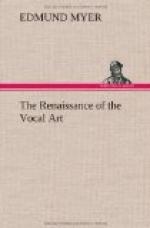There is a stage of study, as we have said, in the experience of all students of the voice, when, in order to become artists, Nature demands of them more than mere sound. There comes a time when every tone of the voice must mean something, must express something, through the character of the tone, the idealized tone. In this way the personal magnetism of the singer is imparted, heard, and felt. This means the expression of thought and feeling through the color and character of the tone, the highest known form of expression. This principle is the greatest known agency for the development of all the powers of the singer, not only the emotional and mental powers, but the physical as well. The student of the voice who studies or who is trained in this way, develops, not only in character and beauty of tone, but in actual physical power and control. This study of tone color and tone character develops new power in every way. “The mechanical and mental alone are but half development, but this is full and complete development of the entire being.” In proof of this, sing a light, bright, happy thought or tone, using the clear timbre, about the middle of the voice. It will require but little strength. Then sing a more emotional thought, sentence, or tone; express deeper feeling, and it will be found that more strength is required. Again, give utterance to tone or words which express sadness, sorrow, or intense pleading, using the somber timbre of the voice, and much more strength will be required. This will be especially noticeable in the action or energy of the diaphragm and abdominal muscles. It will be found that the low muscles of the body exert more strength on somber timbre than on clear tone. This, in order to induce the deep, low setting of the voice at the organ of sound, necessary for the production of somber or dark tone, and the expression of deep, emotional feeling. It is easy to see that this means greater physical as well as emotional development; physical development, not only of every muscle of the body, but of the organ of sound itself; a development which can be attained through the study of tone color and emotional expression only.
The power of vitalized emotional energy, I might say the power of the emotional power, cannot be overestimated. The power of an emotional climax, imparted through the soft color of the voice, is often greater than that of the dramatic climax; it will often influence and affect an audience in the most startling way. We find that thought and will control all physical action in singing. If the thought is right, the action will be right; if wrong, the action will surely be wrong. When right thought and action have developed absolute freedom, then the emotional energy, the singer’s sensation, the true power of the voice, should dominate everything. The mind or will controls the body through thought, but the thought must be aroused through feeling or emotion; and the feeling or emotion is inspired by the sentiment to be expressed. This means, of course, the higher form of expression, means the power of tone color and tone character; but it depends first upon all true conditions of tone, mental and physical, and then upon the temperament, upon the heart, and soul of the singer.




